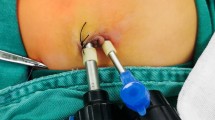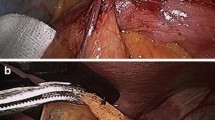Abstract
Background
Little is known about the advantages of laparoscopic truncal vagotomy with gastrojejunostomy (LTVGJ) over open truncal vagotomy with gastrojejunostomy (OTVGJ) for peptic pyloric stenosis (PPS). This study aimed to highlight the role of minimally invasive surgery in the form of LTVGJ for PPS.
Methods
From March 1999 to October 2005, 21 patients with PPS underwent LTVGJ (n = 13) and OTVGJ (n = 8). We analyzed intraoperative and postoperative outcomes retrospectively.
Results
Two groups had similar demographic characteristics. Significantly shorter operating time, hospital stay, time to presence of bowel sounds, and time to tolerate a diet were the advantages of LTVGJ, while blood loss was higher in OTVGJ. There were significant differences in weight gain between the two groups after surgery during follow-up.
Conclusions
This study suggests that LTVGJ is a feasible technique, and intermediate follow-up reveals good symptomatic results when used for PPS.


Similar content being viewed by others
References
Solt J, Bajor J, Szabó M, Horváth OP (2003) Long-term results of balloon catheter dilation of benign gastric oulet stenosis. Endoscopy 35:490–495
Bloom BS (1991) Cross-national changes in the effects of peptic ulcer disease. Ann Intern Med 114:558–562
Fowler DL (1994) Gastric resection. In: Ballantyne GH, Leahy PF, Modlin IM (eds) Laparoscopic surgery. Saunders, Philadelphia, pp 441–443
Wyman A, Stuart RC, Ng EK, Chung SC, Li AK (1996) Laparoscopic truncal vagotomy and gastroenterostomy for pyloric stenosis. Am J Surg 171:600–603
Laws HL, McKernan JB (1993) Endoscopic management of peptic ulcer disease. Ann Surg 217:548–555
Bardhan KD, Cust G, Hinchliffe RF, Williamson FM, Lyon C, Bose K (1989) Changing pattern of admissions and operations for duodenal ulcer. Br J Surg 76:230–236
McConnell DB, Baba GC, Deveney CW (1989) Changes in surgical treatment of peptic ulcer disease within a veterans hospital in the 1970s and the 1980s. Arch Surg 124:1164–1167
Griffin SM, Chung SC, Leung JW, Li AK (1989) Peptic pyloric stenosis treated by endoscopic balloon dilatation. Br J Surg 76:1147–1148
Chisholm EM, Chung SC, Leung JW (1991) Peptic pyloric stenosis after the balloon goes up. Gastrointest Endosc 37:240
Uddo JF Jr (1994) Antrectomy with Billroth II anastomosis. In: Ballantyne GH, Leahy PF, Modlin IM (eds) Laparoscopic surgery. Saunders, Philadelphia, pp 444–448
Goligher JC (1970) The comparative results of different operations in the elective treatment of duodenal ulcer. Br J Surg 57:780–783
Wastell C (1969) Long-term clinical and metabolic effects of vagotomy with either gastrojejunostomy or pyloroplasty. Ann R Coll Surg Engl 45:193–211
Goligher JC, Feather DB, Hall R, Hall RA, Hopton D, Kenny TE, Latchmore AJ, Matheson T, Shoesmith JH, Smiddy FG, Wilson-Pepper J (1979) Several standard elective operations for duodenal ulcer: ten to sixteen year clinical results. Ann Surg 189:18–24
Lee J, O’Morain C (1997) Who should be treated for Helicobacter pylori infection? A review of consensus conferences and guidelines. Gastroenterology 113(Suppl 1):S99–S106
Turnage RH, Sarosi G, Cryer B, Spechler S, Peterson W, Feldman M (2003) Evaluation and management of patients with recurrent peptic ulcer disease after acid-reducing operations: a systematic review. J Gastrointest Surg 7:606–626
Naesgaard JM, Edwin B, Reiertsen O, Trondsen E, Faerden AE, Rosseland AR (1999) Laparoscopic and open operation in patients with perforated peptic ulcer. Eur J Surg 165:209–214
Lunevicius R, Morkevicius M (2005) Systematic review comparing laparoscopic and open repair for perforated peptic ulcer. Br J Surg 92:1195–1207
Gortz L, Bjorkman AC, Andersson H, Kral JG (1990) Truncal vagotomy reduces food and liquid intake in man. Physiol Behav 48:779–781
Liakakos T, Thomakos N, Fine PM, Dervenis C, Young RL (2001) Peritoneal adhesions: etiology, pathophysiology, and clinical significance. Recent advances in prevention and management. Dig Surg 18:260–273
Author information
Authors and Affiliations
Corresponding author
Rights and permissions
About this article
Cite this article
Kim, SM., Song, J., Oh, S.J. et al. Comparison of laparoscopic truncal vagotomy with gastrojejunostomy and open surgery in peptic pyloric stenosis. Surg Endosc 23, 1326–1330 (2009). https://doi.org/10.1007/s00464-008-0160-1
Received:
Revised:
Accepted:
Published:
Issue Date:
DOI: https://doi.org/10.1007/s00464-008-0160-1




